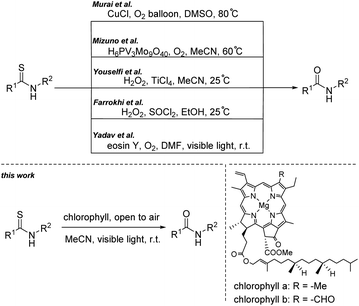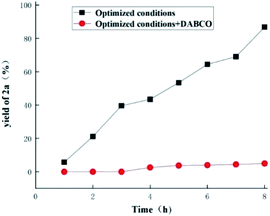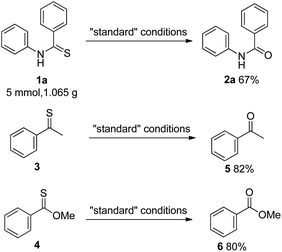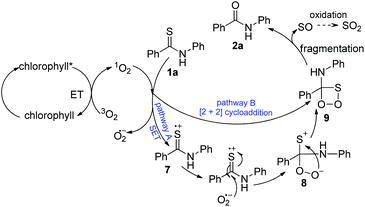 Open Access Article
Open Access ArticleVisible-light-promoted and chlorophyll-catalyzed aerobic desulfurization of thioamides to amides†
Zihui Yanga,
Haoyi Zhoua,
Lin Wanga,
Jingxuan Zhanga,
Hongqi Xieab,
Yisong Liuab,
Jianguo Zengab and
Pi Cheng *ab
*ab
aHunan Key Laboratory of Traditional Chinese Veterinary Medicine, Hunan Agricultural University, Changsha, Hunan 410128, China. E-mail: picheng55@126.com; picheng@hunau.edu.cn
bCollege of Veterinary Medicine, Hunan Agricultural University, Changsha, Hunan 410128, China
First published on 9th June 2022
Abstract
A novel method for the metal-free synthesis of amides from thioamides based on visible-light photoredox catalysis and in an air atmosphere is reported. Natural pigment chlorophyll is used as a photosensitizer to generate singlet molecular oxygen 1O2, which is involved in the aerobic desulfurization of thioamides. The protocol provides amides in good yields at room temperature under mild conditions. On the basis of experimental results, a plausible photoredox mechanism is proposed.
Introduction
In synthetic organic chemistry, developing clean and environmentally benign chemical processes using less hazardous catalysts is of great importance and has become a primary goal. In the past decade, visible light photoredox catalysis has become a powerful tool for green organic synthesis due to its sustainability, mild reaction conditions and the potential application of visible light.1In nature, chlorophyll is the most abundant natural visible light photocatalyst.2 Based on the powerful catalytic ability of chlorophyll, plants use sunlight as the energy source to convert CO2 and H2O to sugars. It is the principal photo acceptor in the chloroplasts of most green plants. Chlorophyll is also an ideal and environmentally friendly photosensitizer with porphyrin structures for reactive oxygen species (ROS) generation such as singlet oxygen 1O2. Although reports emerged on the use of singlet oxygen in the synthesis of natural products in the 1980s, chlorophyll was rarely applied in photo driven synthesis. In 2015, Boyer et al. utilized the electron transfer mechanism of chlorophyll under light to control radical polymerization.3 In 2017, He et al. reported a chlorophyll-catalyzed synthesis of tetrahydroquinolines mediated by visible light.4 Inspired by the two precedents of chlorophyll in photosynthesis, we envisaged that it may be possible to use chlorophyll as a highly efficient photosensitizer in visible-light catalysis for organic synthesis or functional group manipulation.
It is well known that thiocarbonyl compounds undergo desulfurization to generate the corresponding carbonyl compounds when treated with stoichiometric oxidants.5 Molecular oxygen is an ideal environmentally benign oxidant. In 2007, Murai's group reported a copper-catalyzed oxidative desulfurization reaction of thiocarbonyl compounds with molecular oxygen as an oxidant (Fig. 1).6 In 2016, Mizuno et al. found that phosphovanadomolybdic acid could also catalyze the same reaction using molecular oxygen as terminal oxidant (Fig. 1).7 However, these transformations required reaction temperature at 80 and 60 °C respectively. Afterwards, Yousefi8 and Frrokhi9 developed H2O2/TiCl4 and H2O2/SOCl2 system respectively and lowered the reaction temperature. Nevertheless, above two systems required equivalent TiCl4 or SOCl2 and generated metal salts or chloride wastes. Based on photoredox strategy, Yadav et al.10 found that photo-activated synthetic pigment eosin Y (3EY*) could act as oxidant to achieve the desulfurization of thioamides under aerobic conditions.
In this study, we report that chlorophyll is able to catalyze the desulfurization of thioamides in an air atmosphere under visible light excitation, which provides an example for exploring environmentally friendly and convenient synthetic methodology utilizing chlorophyll and light energy in organic chemistry.
Results and discussion
The natural pigment chlorophyll powder used in this research was purchased from Tokyo Chemical Industry (TCI). This is a mixture powder of chlorophyll, lactose, and dry gum arabic, in which the total chlorophyll is 0.5% (the mass percentage). Initially, a model reaction was carried out with thioamide N-phenylbenzothioamide (1a). As shown in Table 1, a solution of 1a in MeCN containing 5 mol% of chlorophyll powder (Fig. 1) was exposed to air atmosphere and irradiated with 455 nm blue LED light at r.t. We were satisfied to found that the reaction gave desired amide 2a in 84% isolated yield after 8 h (Table 1, entry 1). Prolonging the reaction time to 12 or 24 h (Table 1, entries 2–3) didn't increase the yield of compound 2a obviously. As control experiments, the reaction was also conducted in darkness or without photosensitizer but only trace of compound 2a could be detected (Table 1, entries 4–5). In order to check if oxygen is necessary in this desulfurization, the model reaction was carried out in degassed solvent under nitrogen atmosphere, and product 2a was only obtained in 7% yield (Table 1, entry 6).| Entry | Variation from the optimal conditions | Yieldsb |
|---|---|---|
| a “Standard” reaction conditions: a mixture of 1a (0.3 mmol) and 15 mg of chlorophyll powder (5 mol%) in 3 mL MeCN was stirred and irradiated with 10 W 455 nm blue light-emitting diodes (LED) at r.t. open to air.b Yield of the isolated product after silica gel chromatography. | ||
| 1 | None | 84% |
| 2 | Prolong reaction time to 12 h | 83% |
| 3 | Prolong reaction time to 24 h | 84% |
| 4 | In darkness | Trace |
| 5 | Without chlorophyll powder | Trace |
| 6 | Under N2 atmosphere in degassed MeCN | 7% |
| 7 | Addition of 2.0 equiv. DABCO | 5% |
| 8 | Addition of 2.0 equiv. of K2CO3 | 54% |
It is well-known that chlorophyll can generate singlet oxygen 1O2 upon irradiation in oxygenated solution. In order to verify the existence of singlet oxygen, we did some control experiments under “standard” reaction conditions. When 0.6 mmol (2 equiv.) of 1,4-diazabicyclo[2.2.2]octane (DABCO), which is known as a quencher of singlet oxygen,11 was added to the model reaction (Table 1, entry 7). The reaction rate was obviously suppressed during the reaction time. Only 5% was obtained in the presence of DABCO after 8 h compared to the yield under “standard” reaction conditions without DABCO (Table 1, entry 7), and no product 2a was observed within the first 3 h (Fig. 2). The results suggested that singlet oxygen must be involved in the reaction mechanism. As comparison, the addition of inorganic base to the model reaction obviously decreased the reaction efficacy but still delivered target compound 2a in 54% yield (Table 1, entry 8).
With the optimized condition in hand, we investigated the substrate scope of this photo-activated desulfurization reaction. First, a series of N-phenylbenzathioamide with different substituents on the benzene ring of aniline were selected as substrates. As shown in Table 2, alkyl, halogen and electron-withdrawing nitro group didn't have any effect on the desulfurization efficacy (Table 2, compounds 2a–2h). Next, we turned our attention to N-alkyl benzothioamide, and were pleased to find that the desulfurization process still underwent highly efficiently (Table 2, compounds 2i–2l). However, the transformation rate of N-benzyl benzathioamide slightly decreased (Table 2, compound 2m). Finally, the effect of acyl groups on the desulfurization reaction was investigated. As illustrated in Table 2, substituents on benzoyl group were tolerant under optimized reaction conditions, giving desired (Table 2, compounds 2n–2v) in good yields. In addition, acetanilide (Table 2, compound 2w) could be obtained under optimized condition using corresponding benzathioamide as substrate. It should also be noted that even primary and tertiary thioamides were compatible with the present catalytic system, giving corresponding amides 2x and 2y in good yields.
| a Reaction conditions: a mixture of 1 (0.3 mmol) and 15 mg of chlorophyll powder (5 mol%) in 3 mL MeCN was stirred and irradiated with 455 nm blue light-emitting diodes (LED) at r.t. open to air. |
|---|
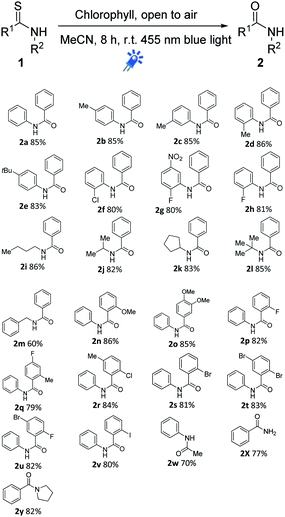 |
To demonstrate the efficiency and applications of this chlorophyll-catalyzed desulfurization reaction, a gram–scale reaction for synthesis of compound 2a was carried out under “standard” condition. To our delight as shown in Fig. 3, target compound 2a was obtained in 67% yield. In addition, phenylethanethione 3 and O-methyl benzothioate 4 were subjected to this desulfurization reaction, and we were pleased to find that corresponding carbonyl compounds 5 and 6 were obtained in good yields (Fig. 3).
On the basis of our experimental results, we proposed the following plausible reaction mechanism (Fig. 4). Unlike the eosin Y-catalyzed desulfurization of benzathioamide,10 singlet molecular oxygen is involved in this chlorophyll-catalyzed reaction. Firstly, the chlorophyll is excited from its ground state to its excited state (chlorophyll*) upon irradiation of visible light. The excited state photosensitizer (chlorophyll*) turns the ground-state oxygen 3O2, forming the singlet oxygen 1O2 via energy transfer (ET) process.12 Meanwhile, the excited state of the photosensitizer goes back to the ground state. At this stage, 1O2 can undergo a single-electron transfer (SET) oxidation of benzathioamide 1a to the thiocarbonyl cation radical 7 (pathway A, Fig. 4). At the same time, singlet oxygen is SET reduced to superoxide anion radicals, which undergoes nucleophilic addition to the C![[double bond, length as m-dash]](https://www.rsc.org/images/entities/char_e001.gif) S double bond of thiocarbonyl cation radical 7. The addition intermediate 8 cyclizes to four-membered ring intermediates 9, which finally fragments to product 2a and sulfur monoxide SO which was further oxidized to SO2 by singlet oxygen. According to Su's research,13 O–O bond of 1O2 can undergo a [2 + 2] cycloaddition to the C
S double bond of thiocarbonyl cation radical 7. The addition intermediate 8 cyclizes to four-membered ring intermediates 9, which finally fragments to product 2a and sulfur monoxide SO which was further oxidized to SO2 by singlet oxygen. According to Su's research,13 O–O bond of 1O2 can undergo a [2 + 2] cycloaddition to the C![[double bond, length as m-dash]](https://www.rsc.org/images/entities/char_e001.gif) S bond of thioamide 1a directly (pathway B, Fig. 4), forming a four-membered ring intermediate 9. The C–S bond in intermediate 9 is thus weakened, and the cleavage of the C–S bond leads to product amide 2a and sulfur monoxide SO which was further oxidized by 1O2 to SO2.
S bond of thioamide 1a directly (pathway B, Fig. 4), forming a four-membered ring intermediate 9. The C–S bond in intermediate 9 is thus weakened, and the cleavage of the C–S bond leads to product amide 2a and sulfur monoxide SO which was further oxidized by 1O2 to SO2.
Conclusions
In summary, a visible-light-promoted and chlorophyll-catalyzed desulfurization of thioamide was developed to access amide. This reaction involves a typical element-transfer process.14 Compared with previously reported aerobic desulfurization methodology, chlorophyll was able to directly excite ground state oxygen to singlet oxygen 1O2 as oxidant featuring non-toxicity, mild reaction conditions and potential applications of visible light. We believe that the chlorophyll-involved aerobic oxidation system has great application prospect in organic synthesis.Conflicts of interest
There are no conflicts to declare.Acknowledgements
This research was financially supported by Changsha Municipal Natural Science Foundation (No. kq2014064).Notes and references
- For selected recent review and research papers, see: (a) L. Chang, Q. An, L. Duan, K. Feng and Z. Wei, Chem. Rev., 2022, 122, 2429–2486 CrossRef CAS PubMed; (b) M. S. Galliher, B. J. Roldan and C. R. J. Stephenson, Chem. Soc. Rev., 2021, 50, 10044–10057 RSC; (c) J. D. Lasso, D. J. Castillo-Pazos and C.-J. Li, Chem. Soc. Rev., 2021, 50, 10955–10982 RSC; (d) A. Trowbridge, S. M. Walton and M. J. Gaunt, Chem. Rev., 2020, 120, 2613–2692 CrossRef CAS PubMed; (e) Y.-Q. Yuan, S. Majumder, M.-H. Yang and S.-R. Guo, Tetrahedron Lett., 2020, 61, 151506 CrossRef CAS; (f) S. P. Pitre and L. E. Overman, Chem. Rev., 2022, 122, 1717–1751 CrossRef CAS PubMed; (g) G. E. M. Crisenza, D. Mazzarella and P. Melchiorre, J. Am. Chem. Soc., 2020, 142, 5461–5476 CrossRef CAS PubMed; (h) C. K. Prier, D. A. Rankic and D. W. C. MacMillan, Chem. Rev., 2013, 113, 5322–5363 CrossRef CAS PubMed; (i) X.-Y. Yu, J.-R. Chen and W.-J. Xiao, Chem. Rev., 2021, 121, 506–561 CrossRef CAS PubMed; (j) Y. Abderrazak, A. Bhattacharyya and O. Reiser, Angew. Chem., Int. Ed., 2021, 60, 21100–21115 CrossRef CAS PubMed; (k) S.-W. Wang, J. Yu, Q.-Y. Zhou, S.-Y. Cheng, Z.-H. Xu and S. Tang, ACS Sustainable Chem. Eng., 2019, 7, 10154–10162 CrossRef CAS; (l) T. Liu, J. liu, J. He, Y. Hong, H. Zhou, Y.-L. Liu and S. Tang, Synthesis, 2022, 54, 1919–1938 CrossRef.
- (a) R. Croce and H. V. Amerongen, Nat. Chem. Biol., 2014, 10, 492–501 CrossRef CAS PubMed; (b) M. Pietrzykowska, M. Suorsa, D. A. Semchonok, M. Tikkanen, E. J. Boekema, E.-M. Aro and S. Jansson, Plant Cell, 2014, 10, 492–501 Search PubMed.
- S. Shanmugam, J.-T. Xu and C. Boyer, Chem. Sci., 2015, 6, 1341–1349 RSC.
- J.-T. Guo, D.-C. Yang, Z. Guan and Y.-H. He, J. Org. Chem., 2017, 82, 1888–1894 CrossRef CAS PubMed.
- (a) M. Nasr-Esfahani, M. Montazerozohori, M. Moghadam, I. Mohammadpoor- Baltork and S. Moradi, J. Sulfur Chem., 2009, 30, 17–21 CrossRef CAS; (b) I. Mohammadpoor-Baltork, M. M. Khodaei and K. Nikoofar, Tetrahedron Lett., 2003, 44, 591–594 CrossRef CAS; (c) D. Cheng, R. Sun and J. Yan, J. Chem. Res., 2012, 36, 210–212 CrossRef CAS; (d) H. J. Kim and Y. H. Kim, Synthesis, 1986, 11, 970–972 CrossRef.
- F. Shibahara, A. Suenami, A. Yoshida and T. Murai, Chem. Commun., 2007, 23, 2354–2356 RSC.
- N. Xu, X. Jin, K. Suzuki, K. Yamaguchi and N. Muzuno, New J. Chem., 2016, 40, 4865–4869 RSC.
- K. Bahrami, M. M. Khodaei, V. Shakibaian, D. Khaledian and B. H. Yousefi, J. Sulfur Chem., 2012, 33, 155–163 CrossRef CAS.
- K. Bahrami, M. M. Khodaei and A. Farrokhi, Tetrahedron, 2009, 65, 7658–7661 CrossRef CAS.
- A. K. Yadav, V. P. Srivastava and L. D. S. Yadav, New J. Chem., 2013, 37, 4119–4124 RSC.
- S. K. Silverman and C. S. Foote, J. Am. Chem. Soc., 1991, 113, 7672–7675 CrossRef CAS.
- A. A. Ghogare and A. Greer, Chem. Rev., 2016, 116, 9994–10034 CrossRef CAS PubMed.
- X. Zou, X. Dai, K. Liu, H. Zhao, D. Song and H. Su, J. Phys. Chem. B, 2014, 118, 5864–5872 CrossRef CAS PubMed.
- C. Chen, Y. Cao, Xi. Wu, Y. Cai, J. Liu, K. Ding and L. Yu, Chin. Chem. Lett., 2020, 31, 1078–1082 CrossRef CAS.
Footnote |
| † Electronic supplementary information (ESI) available. CCDC 2160655. For ESI and crystallographic data in CIF or other electronic format see https://doi.org/10.1039/d2ra01930b |
| This journal is © The Royal Society of Chemistry 2022 |

